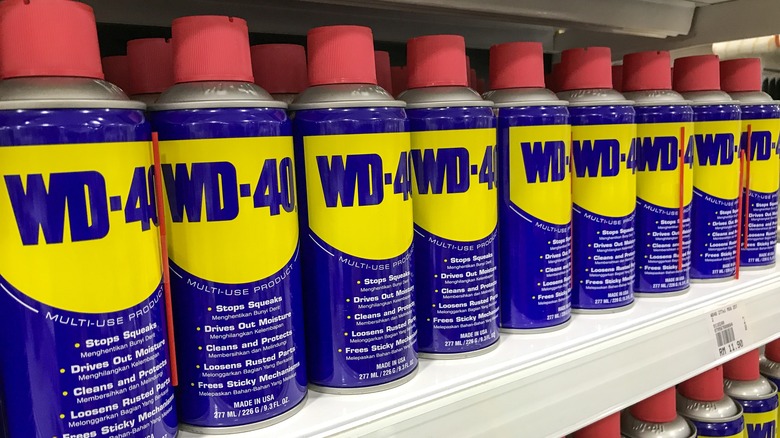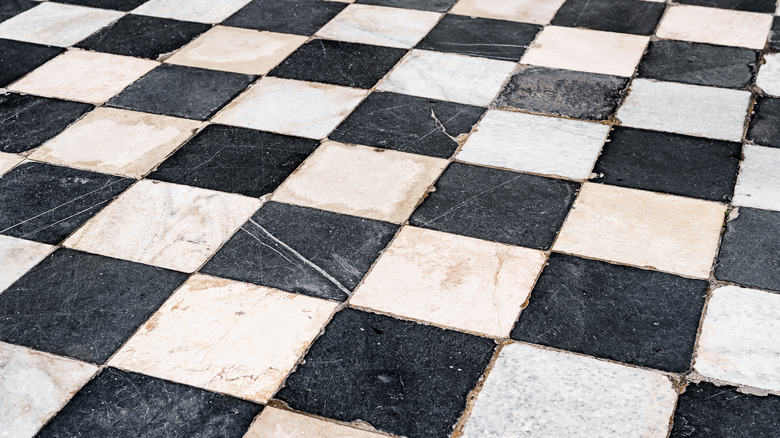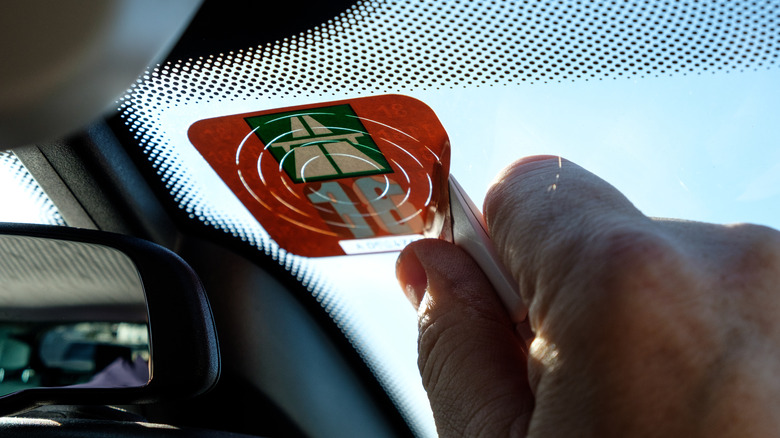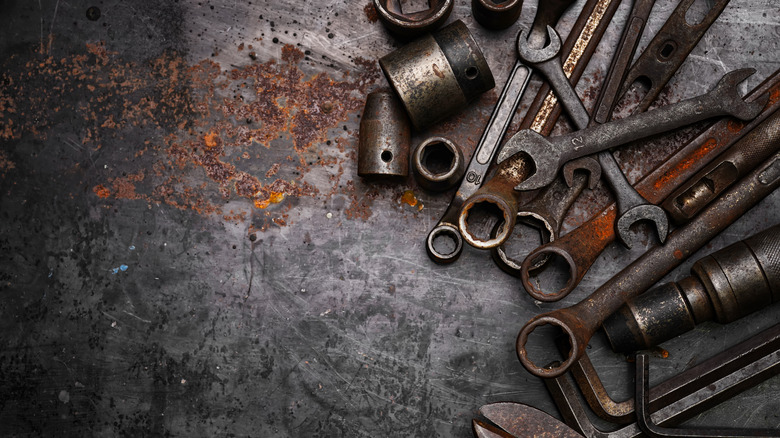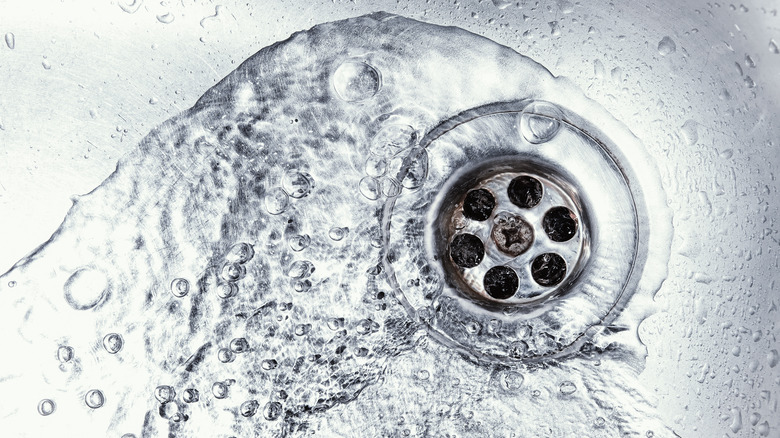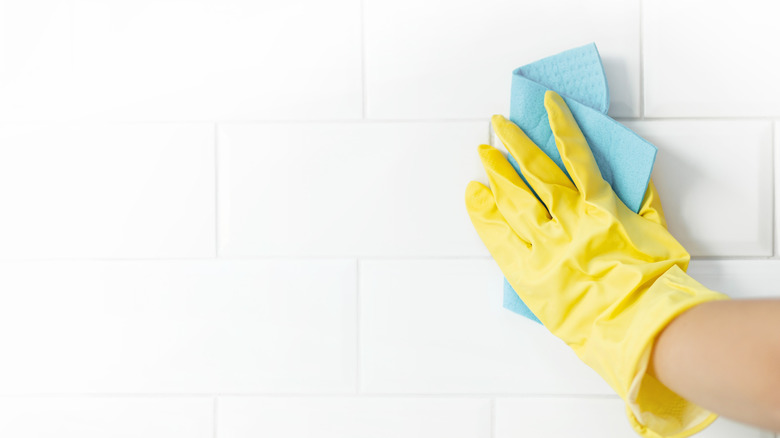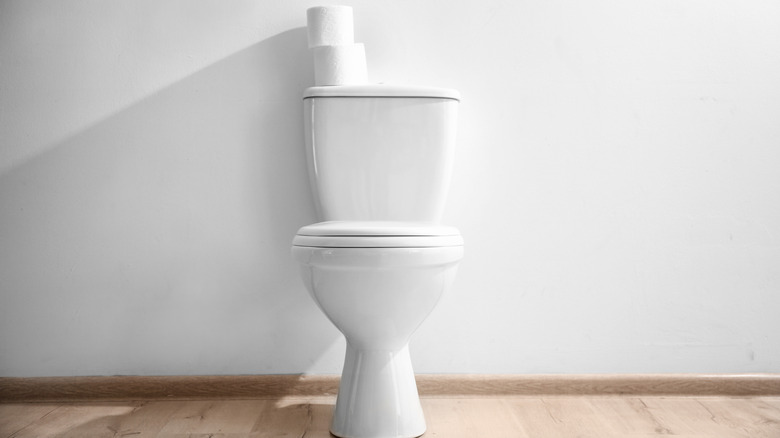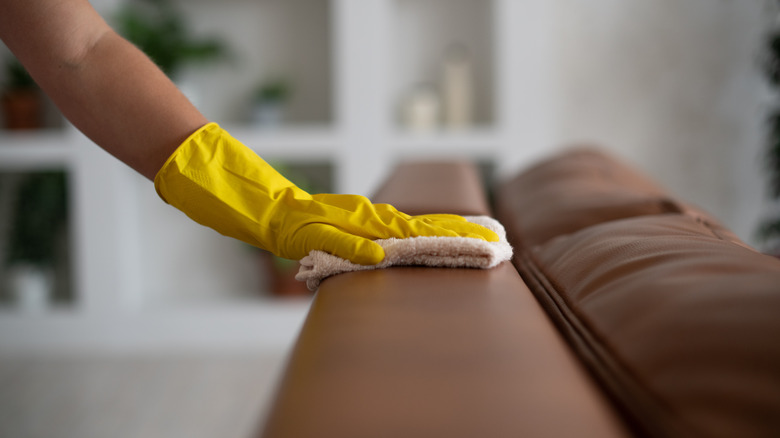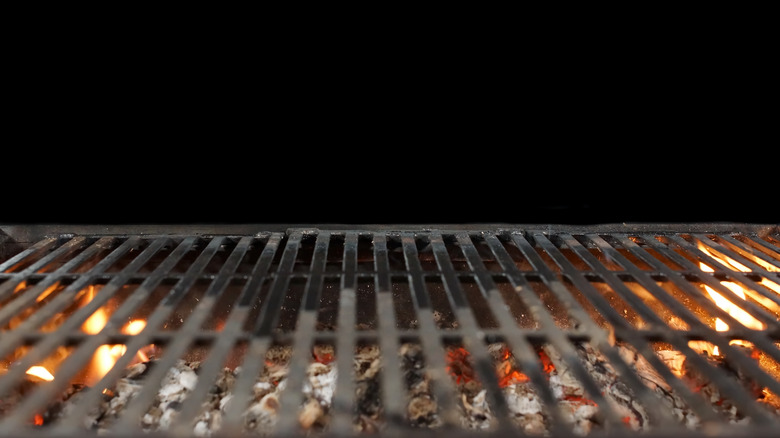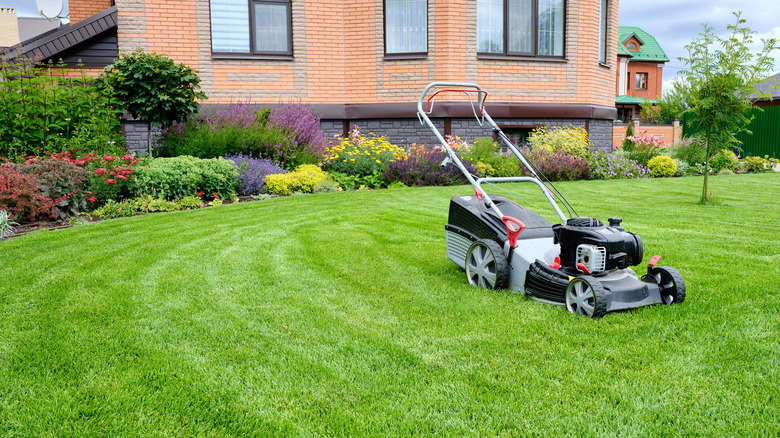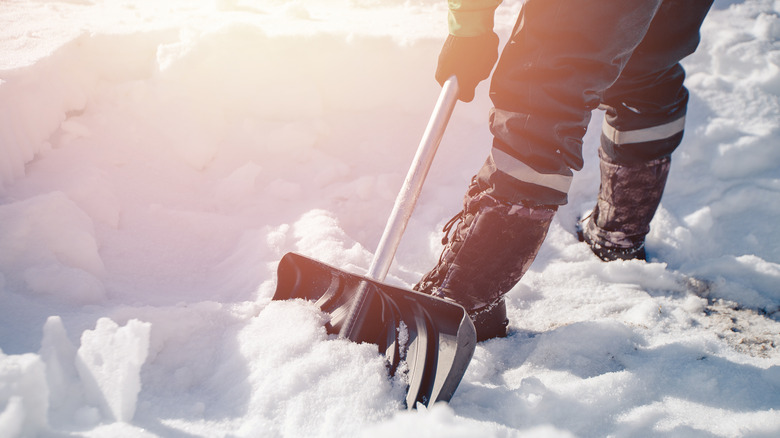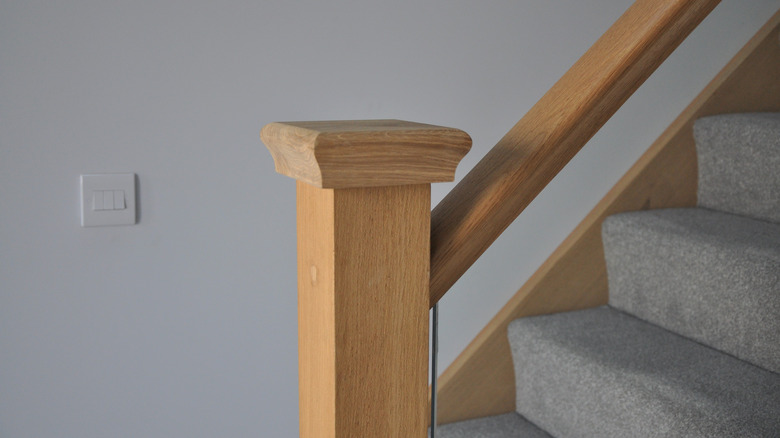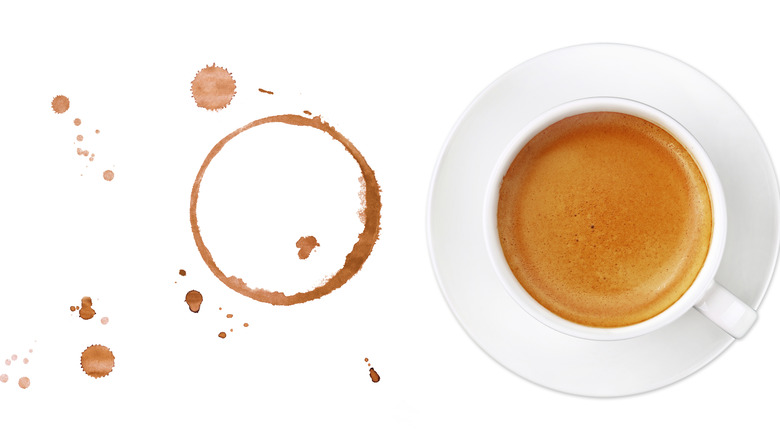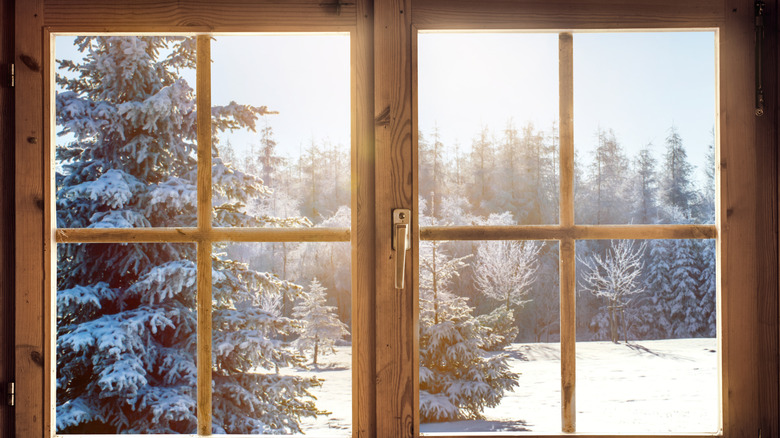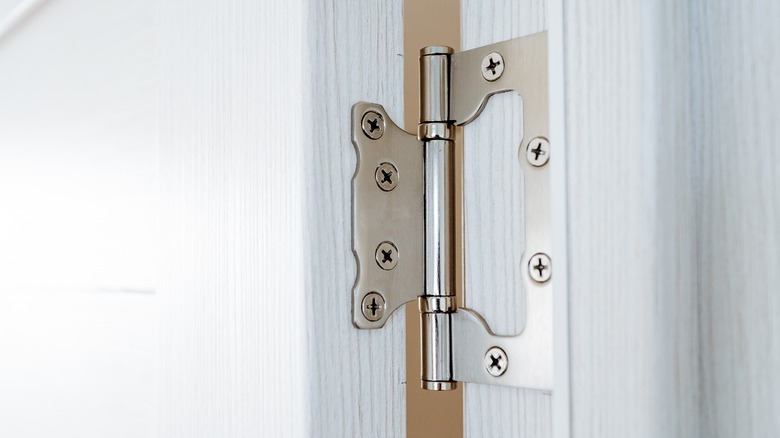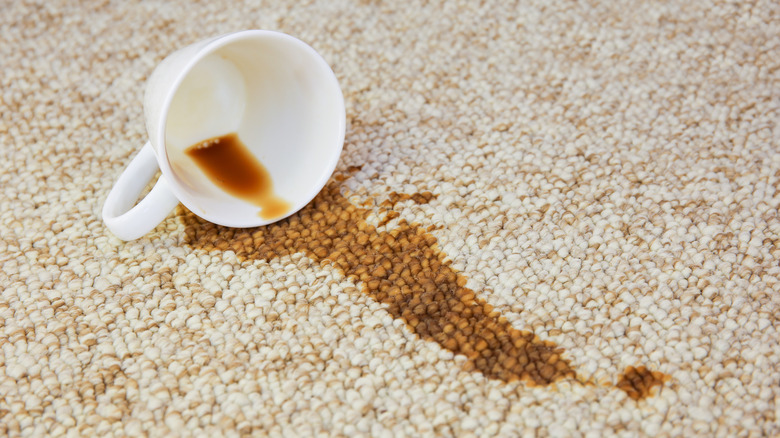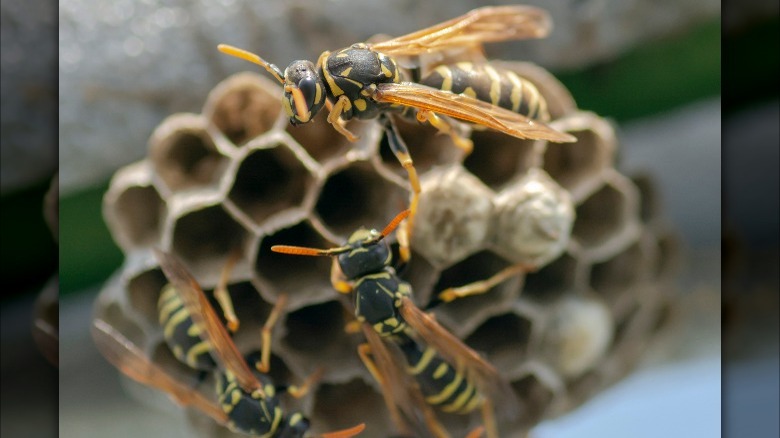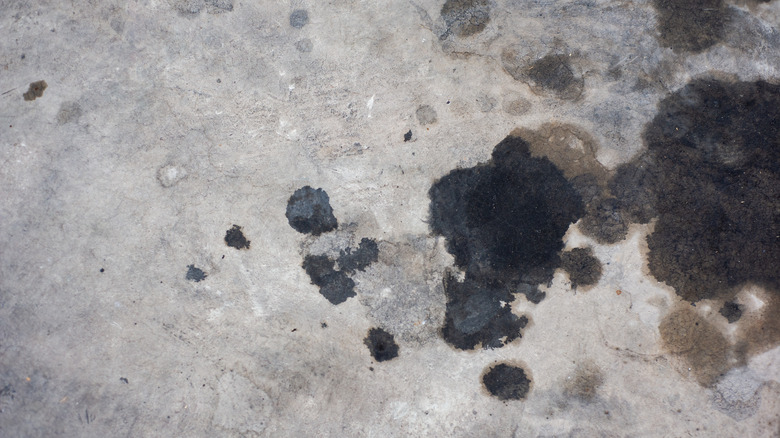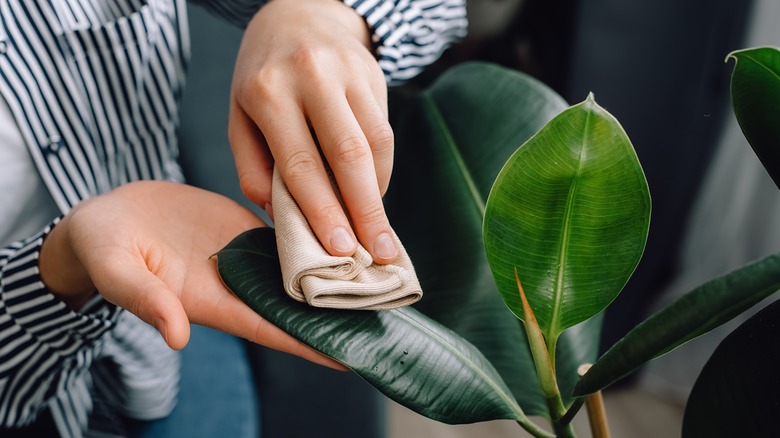20 Genius Tips For Using WD-40 At Home
We may receive a commission on purchases made from links.
You may have heard of WD-40 as one of those products that can be used in multiple ways, even if you always turn to it for the same reason time and time again, such as lubricating a squeaky door hinge, for example. However, that can with the signature logo on the vibrant yellow background likely has way, way more uses than you would have ever thought — in fact, according to the WD-40 website, there are over 2,000 documented uses.
There's a use for just about every area in your house, and just about every tricky task on your list. To that end, if you don't already have a can of this product in your home maintenance arsenal, trust us — you'll want to go grab some from the store to have at home. It'll likely come in handy more often than you think. Here are just 15 of the many uses for WD-40.
Remove scuff marks from the floor
With regular use, even if you're careful, your flooring can get various scuffs and scratches over the years. Next time you spot an unsightly scuff in a high-traffic area, don't fret — just reach for that can of WD-40. All you really have to do is spray the area and then wipe the scuff away, although you may want to follow up by cleaning the floor as you normally would to get rid of any WD-40 residue.
Get rid of residue from stickers, labels, etc.
Whether you've purchased a new glass vase from TJ Maxx or labelled various jars in your pantry that you later want to change, let's face it — nothing is more frustrating than painstakingly peeling away a sticker or label, only to be left with that tacky residue. However, the solution for that turns out to be WD-40. Spray the area with WD-40 and let it sit for at least one minute, longer if the residue is especially stubborn. Then, wipe the WD-40 away with a cloth or paper towel. If there is still sticky residue, apply a bit more WD-40. In no time, any trace of stickiness should be gone!
Prevent rust
If you're the type to always accidentally leave your metal tools outside in the rain or snow, there's an easy hack for that: When you spot those tools that were forgotten, simply coat them with some WD-40, as the brand's own website suggests. The lubricating substance should help to prevent rust from forming on those tools, so you won't be fretting about having to replace all the implements that you left on the lawn.
Remove any stains from your stainless steel sink
Stainless steel sinks are relatively easy to clean and sanitize, but occasionally you may end up with a particularly stubborn stain that just doesn't seem to budge. In cases like that, reach for a can of WD-40. The multi-use substance will help you tackle that stain, once and for all, whether it's because of rust, hard water, or grease, as WD-40 Australia explains. All you need to do is spray the solution onto the affected area and then wipe away — simple!
Tackle tile grout grime
Even if you clean your bathroom on a regular schedule, it can be challenging to clean the grout — we'd wager that very few people have the patience to scrub along every inch of the grout during their weekly deep-clean. An easy way to tackle this job is to spray WD-40 on the area you're looking to deep clean, and then wash it with soapy water. This tip applies to tile anywhere in your home, from bathroom floor tile to a kitchen backsplash.
Get permanent marker off a whiteboard
Whether it was you or someone else in your household who reached for the wrong marker, it can be frustrating to discover that you've accidentally made a permanent mark on your whiteboard. Before you go tossing the board out, or looking for something to cover up the mark, try reaching for WD-40. Simply spray it either on the board itself or on a cloth, then wipe away at the spot you're trying to remove. The solvents in WD-40 help break up permanent marker ink, restoring your whiteboard to look like new.
Clean the toilet bowl
Anything that makes the dreaded task of deep cleaning your toilet bowl easier is a plus in our book. WD-40 can be a great choice for the job, particularly if you're trying to get rid of lime stains or other stubborn marks. As with most tips for WD-40, all you really need to do is spray it onto the area you're looking to address — the bowl of your toilet, in this case — give it a few minutes to do its thing, and then scrub away all that grime.
Condition leather furniture
Is your leather armchair looking a bit worse for wear? Before you go investing in expensive substances meant specifically to condition leather, you might want to try reaching for your can of WD-40 instead. It can help clean and lubricate the leather, serving multiple functions to keep your furniture looking as incredible as when you bought it. All you really need to do is buff the product into the leather surface and wait for the results.
Clean your grill
If you love to grill on a regular basis, but aren't the biggest fan of deep-cleaning your barbecue after each use, turn to WD-40 for a quick and easy solution. The product can be sprayed onto a cooled grill that's looking a bit grimy and then scrubbed away with a wire brush. You may still want to rinse off the grill afterward with some regular soap and water, but the WD-40 means you won't have to use quite as much elbow grease to get your grill gleaming.
Clean lawn mower blades
The last thing you want when you're pushing your lawn mower around the yard is for the blades to get all clogged up with grass, to the point where they're not functioning as they should be. Keep a can of WD-40 handy for that purpose, according to the WD-40 website. Apparently, the versatile substance can prevent those pesky blades of grass from sticking to the blades of your lawn mower, making the whole process a lot smoother.
Lubricate snow shovels
Just as WD-40 works as a lubricant in areas like door hinges, it can use those same lubricating properties to make certain tasks, like shoveling snow, a little more effortless. If you live in a cold climate with plenty of snowfall and shoveling is a constant task, before you head out there, coat your shovel with a thin layer of WD-40. This will help prevent the snow from sticking to the snow shovel, and encourage it to simply slide off for an easier process.
Prevent splinters
Every material, from metal to wood to fabric, has its pros and cons, but there's one particular con that can arise with any type of wooden object: the risk of splinters. Whether you noticed a dangerous-looking area on the handle of a gardening tool you use, or whether you see a rough spot on a wooden table or chair, you can turn to WD-40. Its lubricating properties will help tame that rough patch of wood and hopefully keep splinters at bay.
Clean collections
While you may think of WD-40 as something that can help enhance an item's utility, dealing with things like squeaky hinges, it can also help improve many objects' appearances. WD-40 can be used as a polishing agent of sorts that you can spray onto a wide variety of items, from artificial flowers to natural items like seashells to metal items. After you buff away the excess, you'll be left with a sparkling final product.
Treat tannin stains
As any caffeine lover knows, if you happen to get a tea or coffee stain on a surface such as your light-colored countertop, it can be challenging to deal with. Luckily, it's yet another area where your trusty can of WD-40 can come in handy. Simply cover the stain with WD-40, and use a damp cloth or sponge to easily wipe away the stain.
Frost proof your windows
Anyone who lives in a chilly climate with plenty of snowfall knows that it can easily build up on your windows, which depending on placement can be challenging or nearly impossible to remove. If you want to ensure your view remains unobstructed during even the biggest blizzards, simply coat the exterior of your windows with a thin layer of WD-40. The lubricating substance creates a barrier of sorts, and the snow will just slide off rather than building up until you're snowed in.
Take care of squeaky door hinges
Do some of the doors in your home squeak or creak as they open or close? The sound of a squeaky door can be very annoying and may even disrupt others in the home that are trying to rest or work. There are a few reasons the hinges on the doors in your home may be making these unpleasant sounds when you open or shut them. One possible reason is that they have not been lubricated recently (or were not properly lubricated in the first place). A second possible explanation is that dirt and other debris were attracted to the lubricant on the hinges. As the dirt mixes with the lubricant, it turns into grime. Fortunately, WD-40 can help with both of these potential causes.
After identifying the squeaky door hinge (or hinges), use a clean microfiber cloth to wipe down the hinge and remove as much dust and dirt as possible. Don't skip this step, otherwise the dust and dirt will simply re-enter the hinge. Next, use WD-40 to spray the hinges and remove any built-up grime. You may find that a can with a flexible straw design works best for this step. As you spray, gunk is likely to drip down. Make sure you're ready to catch these drips on a rag. Finally, apply one more layer of WD-40 to re-lubricate the hinges. Now, your door(s) should be much quieter as they open and close.
Clean carpet stains
When you're looking at a stain on your carpet and wondering how you'll be able to get it out, WD-40 may be one of the last products that comes to mind. Believe it or not, however, it can actually be an effective carpet stain remover. The specific procedures for removing a stain can vary depending on what was spilled on the carpet. For most stains, you will want to start by using a clean and dry towel to blot the surface. This will remove as much excess liquid as possible. Just take care not to rub with the towel, as it can cause it to spread or become more set into the fibers. After blotting, grab a microfiber towel and dampen it with WD-40. Use the towel to pat the stained area. After all the discoloration has been removed, use a clean towel to wipe off anything remaining on the surface.
If you're trying to remove pet stains from your carpet, you'll need to take a few additional steps. First, before patting the stain with the WD-40 dampened cloth, you'll want to neutralize the odors. Pouring a mixture of white vinegar and warm water over the stain and letting it soak until dry can help accomplish this task. After it has dried, then follow the procedures above to pat the affected area with a lint-free cloth dampened with WD-40.
Prevent wasp nests
WD-40 can be helpful both in keeping wasps from returning to old nesting sites — as they tend to do — and for killing wasps in an active nest. If you have any old wasp nests on your property, start by carefully removing any remnants. Do not touch the nests with your hands; wear gloves and use a broom to knock them down. Transfer the old nests to a sealed plastic bag and throw them out. Then, use WD-40 to spray all the areas you removed the old nests from. You can also spray other locations where you have seen wasps in the past or where they are likely to build a future nest (such as under your gutters or eaves).
If you're already dealing with an active wasp nest, WD-40 can also help you remedy the problem. You'll want to wait until the wasps are less active during the evening hours and thoroughly spray the entire nest with WD-40. After about an hour, all of the wasps that were in the nest when you sprayed should be dead, and you can use a broom to knock it down. Put on rubber gloves, long pants, and a long shirt before heading out to keep any wasps that may still be living from stinging you.
Remove oil stains in the garage
If you have oil stains on your driveway or in your garage, WD-40 can help get rid of them. If the stain is fresh, start by using some paper towels to soak up as much excess oil as possible. Before tossing the paper towels in the trash can, verify appropriate disposal methods based on your local laws. Then, cover the stain with WD-40. Now is not the time to try to conserve resources; you want to make sure the entire stain is fully covered. Let the WD-40 sit for about 15 minutes — keep pets and children away from the area as the stain is soaking.
Next, use a coarse-bristled cleaning brush to scrub the oil spots until they loosen. Rinse the area with water — hot water will be most effective. If there are still any oil spots, you can repeat the steps above to make them less visible. Finally, use baking soda or cat litter to soak up any remaining oil or residue off of the garage floor or driveway.
Clean artificial plant leaves
If you have artificial plants in your home, then you already know how difficult they can be to clean. Each leaf can collect dust, pet hair, and other debris, and there are tons of leaves on the plant, so keeping them clean can be a daunting task. Moreover, even when you do take the time to wipe down all the leaves, they often look dull and lack the shine they had when they were new. Not only can dull leaves make the plant less aesthetically pleasing, but they also make it more obvious that it is not a real plant.
Fortunately, WD-40 can come to the rescue and breathe some new (artificial) life into your plants, helping them look clean and more realistic. Using WD-40 on the leaves will give them a nice shine that will enhance their overall appearance. All you need to do is apply some WD-40 to a microfiber cloth. Use that cloth to wipe down each leaf. As you wipe, dust and grime will come off, leaving behind a brilliant shine.
